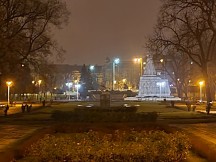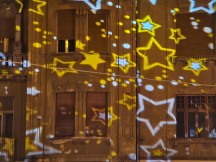Samsung Galaxy Note20 Ultra long-term review

Camera
The Note20 Ultra reuses the main camera sensor from the S20 Ultra, but with a very important tweak: the Note got a laser autofocus system that greatly improves focusing at close distances compared to the S20 Ultra. The latter was notoriously prone to focus hunting and randomly losing focus, and that has mostly been fixed for the Note20 Ultra. Not entirely, but right now the slight focus issues are definitely something you can live with, which isn't something we were able to say for the S20 Ultra in our long-term review of that device.

The ultrawide camera is reused as well, and thus it doesn't have autofocus - it's a small change that you only get in the S21 Ultra. Samsung is really delivering upgrades drop by drop.
You can sort of use the main sensor on the Note20 Ultra for closeups and because it's so huge it also produces among the most natural bokeh of any phone. That said, the focus plane is still quite shallow, so if you're shooting big objects that take up a lot of the frame, you will find that their edges aren't in focus. That's a hardware limitation of the sensor here, and there's nothing Samsung can do about it in software unfortunately.
The 12 MP 5x optical zoom periscope telephoto camera is different from the one we saw in the S20 Ultra, which was a 48 MP 4x unit. The Note20 Ultra's is smaller, and we'll see how that affects image quality in a minute. The selfie cam seems to be swiped directly from the S20 and S20+, with identical specs and 10 MP resolution.

Samsung's camera app has remained the same, with a familiar UI. It's very easy to use though, and we really like that you can choose which shooting modes appear in the carousel. As with seemingly every other camera app out there, you swipe left and right to switch modes, while vertical swipes switch between rear and front cameras.
Zooming is designated by using Samsung's trademark tree icons, and thankfully the zoom tree takes you straight to the native 5x level of the periscope camera (whereas the S20 Ultra would take you to 5x even if 4x was its native zoom level). So a bit of sanity was restored. Continuing that trend, the maximum zoom level is 50x, gone are the 100x Space Zoom shenanigans, and they definitely won't be missed. Even at 50x, shots look like oil paintings, so we'd refrain from ever using this level unless absolutely necessary.
Samples
During the day, the main sensor produces images that are instantly recognizable as coming from a Samsung smartphone, with ample sharpness (sliding into oversharpening a lot of times, especially when dealing with certain textures) and saturation. The shots are also ever so slightly warmer looking than actual reality, but overall Samsung's 'enhancements' do make for very appealing images. It's like the company has managed to find a way to improve upon what our eyes see, in ways that mostly don't seem too overdone. Fans of accuracy will have to look elsewhere, though (or use the Pro mode).
Dynamic range is outstanding and noise is almost non-existent. As usual for long-term reviews we have refrained from capturing samples at the sensor's full resolution, because these pixel binning sensors aren't really meant to be used that way. While you may get a tiny bit more detail by going that route, you are sacrificing everything else in the process.
























Daytime samples from the main sensor
The ultrawide has a similar colorful saturated look, with good dynamic range and decent levels of detail, although overall sharpness could be better. Lens correction works well to correct lines along the edges.





















Daytime samples from the ultrawide
The telephoto produces sharp pictures during the day, with the same 'larger than life' colors and very low noise. These are very good overall.
At night the main sensor delivers images with great dynamic range, good color saturation, lots of detail, and low noise, if not the lowest.
























Nighttime samples from the main sensor
If you use Night Mode on the main sensor, you will get a ton of contrast, along with improvements in dark areas and reigned in highlights, with less haloing around light sources - although it's not almost obliterated, as we've seen in other phones. Night Mode images are pretty quick to shoot too, so more often than not it may pay to go with this instead of Auto if you can.















Night Mode samples from the main sensor
The ultrawide struggles at night, less than ultrawides on mid-rangers, but more than other ultrawides on flagships (the Huaweis come to mind). It produces decent images overall, when there's still some light around. Saturation is good and the pictures are pleasant to look at, although obviously inferior to what's coming from the main cam. There is however a steep cutoff when you venture into less well-lit spaces, you'll struggle to tell what exactly it was you were trying to shoot.





















Nighttime samples from the ultrawide
Add Night Mode to the ultrawide and the darker areas are brightened, bringing to front a lot of detail that simply wasn't there in Auto mode. There's less noise too, while detail in the already lit up areas suffers but not too much. The only issue is that it takes around 7-9 seconds to capture a Night Mode shot with the ultrawide, and that's kind of a lot to sit still trying not to shake. So at night we think you should only go with the ultrawide if you absolutely must fit more into the frame than the main sensor allows for. But if you do need to use it, then Night Mode would be the best way to go.















Night Mode samples from the ultrawide
The telephoto at night is only used when there's enough light around, otherwise the phone switches to using a crop from the main sensor. When the periscope is being used, it shoots reasonably sharp and detailed photos with nice looking colors and decent dynamic range, although with plenty of noise too. If instead you're served a crop from the main sensor, then things are worse, sometimes bordering on unusable blotchy messes. You can tell from our samples which was which, undoubtedly.
If you employ Night Mode for zoomed shots, things do improve somewhat thanks to the longer exposures, but you're still going to struggle to find any such shots usable unless you're surrounded by plenty of light. And there's also the disadvantage having to do with how long it takes to capture a Night Mode shot, except, unlike for the ultrawide, for zoomed pictures the difference in quality isn't as huge.
Selfies are weird to capture because by default you're shown a crop of the sensor, a zoomed in view if you will. The camera would automatically switch to the full view when it detects more than one face in the frame. Alternatively, a toggle hidden deep in the camera settings would let it remember the last used framing setting but we can only guess why this isn't on by default.
Selfies come out okay during the day, with good detail levels, though colors can be muted compared to what the rear cameras give you. Dynamic range is excellent, and Live focus (don't call it Portrait mode) is very good for a single-camera solution. It can generally obtain good subject separation, even if it's not perfect all of the time.








Daytime selfies, normal/wide, Live focus off/on
At night the quality predictably goes down, and as with all standalone selfie cameras (that aren't the rear ones rotating towards you like in the Zenfone line from Asus) it's best to stick with places where there's at least some ambient lighting around, in order for the resulting shots to be even barely usable. Below you can see samples in Auto mode, Night mode, and with Live focus.












Nighttime selfies, normal/wide, Night mode off/on, Live focus off/on
To sum up our camera experience, the Note20 Ultra has a very competent system in tow, which is definitely among the best out there. To our eyes, though, it's definitely not the best at anything. The Huawei Mate 40 Pro/Pro+ and P40 Pro/Pro+, as well as the Xiaomi Mi 10 Ultra all rise above it in the camera department, and not by a small amount. However, the differences are sometimes only obvious when you're looking for them, so for most people posting primarily to social media, the Note20 Ultra has the advantage of 'the Samsung look' which seems like it was tailor made for grabbing your glance while you're scrolling through Instagram.
Reader comments
- ee
- 24 Dec 2024
- KAp
its the stabilization camera noise
- Eburner
- 17 Jun 2024
- IbI
How can the Pic 📸 quality not surpass the Note 9? That sounds pathetic to me, and Samsung aught to give a discount to every Note 20 Ultra. ☹️😠
- LM93
- 27 Oct 2023
- Xyb
I have had a P30 Lite since 2016 and haven't had a problem with it, however, I am now considering upgrading to a Note 20 Ultra as it has recently become available at one of the service providers in SA. Considering that it has Recieved its final ...















































